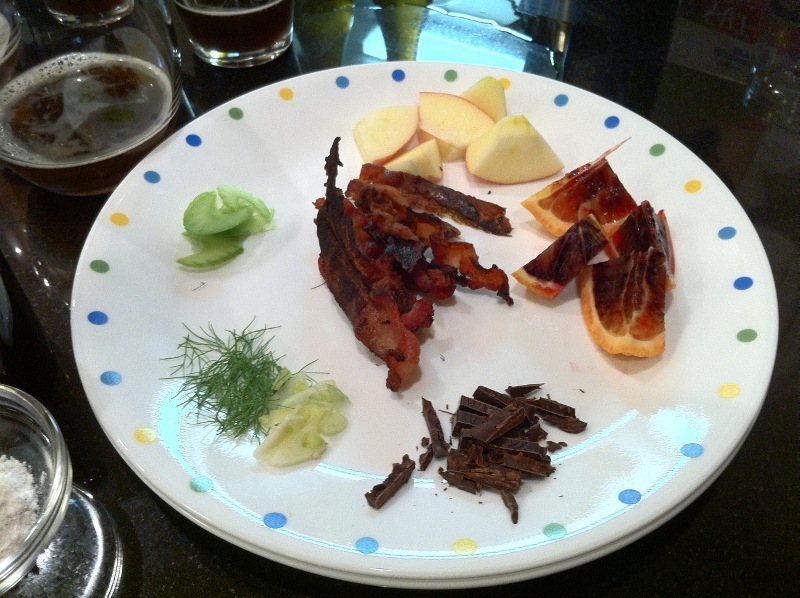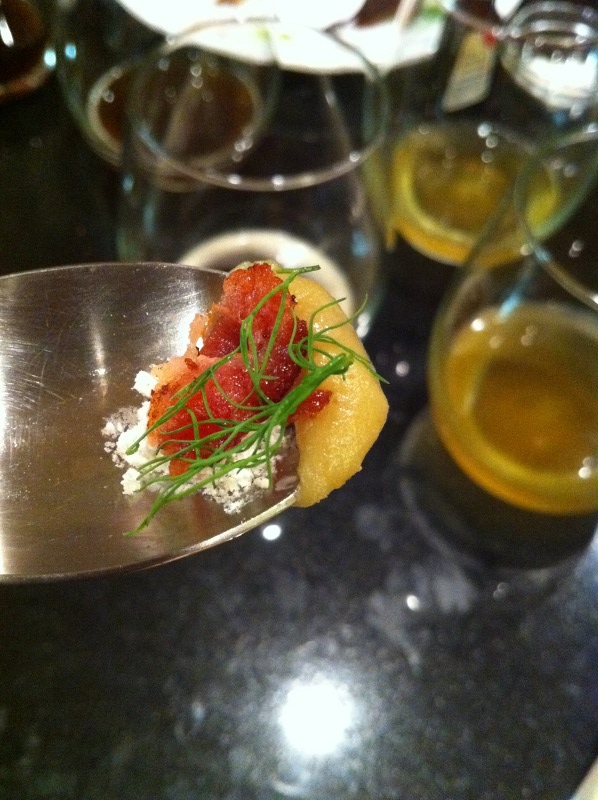I’m going to take a short break from cooking recipes directly from the cookbook. My friend Kris and I are scheming up a little project that leverages what I’ve learned so far from this style of cooking towards a Thanksgiving Dinner. I’ll likely be modeling some things after various components in the book, but overall I’d like to do as much as I can without referring to recipes. The ultimate danger I foresee from doing this isn’t outright failure, but that my tastes and sensibilities aren’t as honed as that of a real chef, so the result might not be as perfect as what’s in the book. But I’d really, really like to get as close as possible. Having said that, then, I’m going to post about work-in-progress stuff until we’re ready for the big dinner, in the hopes that anyone reading this will offer opinions if they see ways I can improve stuff. Interactive blogging!
One of the things I’d like to do is make a dish that features Chestnut. The cookbook has a Chestnut, Many Garnishes dish, which I’ve tried specifically to not look at to keep myself fresh. There’s another recipe involving Beer and Almond Paste, though, that’s piqued my imagination for a while now. At the moment, its visual presentation and architecture is largely what I’m borrowing from. I’m generally not a super-avid fan of belgian beer, but my friend Francisco (and, to a slightly lesser extent I think, Joe) are, and thanksgiving seems the perfect forum to feature a belgian beer.
So I’m starting from the idea of a dish called Beer, Chestnut, Something, Something.
Every great chef knows that all cool things start with some sciencing. You science up some stuff and you get good food, then you get invited to Harvard and Oprah. So, I need some science. A LOT of it.
I started two nights ago trying to make basic chestnut paste. The recipe I made up was:
–250g chestnut
–cut X in base of chestnut with knife to allow steam to escape
–toast at 400F for 20 minutes until aromatic
–peel and skin chestnuts. Burn fingers in process.
–Cook chestnuts en sous vide for 50 min at 200F. (I did this because I thought I needed to tenderize them further, and worried that boiling them would lose all the ‘toasty’ flavor).
–puree in blender.
At this point, I thought the tenderized chestnuts would behave like peanuts, in that they would just turn into paste. This is not the case at all; chestnuts are very fibrous, not really oily at all, so they kinda turned into chestnut dust. I slowly added water to the blender, which caused the dust to seize up into a gummy paste and my blender overheated. So I removed the gum and refrigerated it. It tasted ok, very, very mild, and the consistency was bad (but I figured I could just loosen it up with more water later). Ultimately I was trying to make the most neutral paste ever, so that I could decide later whether it wanted to be sweet or salty.
At this point I cheated and looked at the Chestnut recipe in the book, just to see how close to the ballpark I was in my approach. Turns out, fairly close. The book boils the chestnuts, without toasting them, in cream and bay for 30 mins before blending them with cream to make a paste. So, I tried a second time:
–250G chestnut
–Cut X in base of chestnut
–Boil for 10 minutes, to help make skinning/peeling easier
–skin/peel
–boil in 300g Heavy Cream, with 2 bay leaves and a large pinch of salt (the large pinch of salt I think was a mistake. it caused the cream to get a bit salty, which I don’t think I liked. Also, note to self: MEASURE EVERYTHING).
–Puree chestnuts with cream, in equal parts (at the end of boiling, I had 200g chestnuts, so added 200g cream)
–add 100g sugar to paste.
The resulting consistency here was really beautiful, so it’s definitely the right way to go. The sugar was my own idea, to try to pull the salty paste back to neutral. It didn’t quite work; the paste, while slightly sweet, had ‘something’ to it that sarah and I posited tasted like…roast chicken. I don’t know if this was the chestnuts themselves, or the result of the salt, or what.
I looked through the Flavor Bible to find Chestnut, and there were a ton of interesting flavor pairings. I jotted down the ones that sounded the most promising to me:
–apple
–orange
–celery
–fennel
–chocolate
–vanilla
–bacon
–nutmeg
–cardamom
–clove
–cream
Once I had some paste that was ‘close enough’, Sarah and I assembled a spread of the above ingredients, to try to hone in on some pairings. This was super-fun.
For the beers, I asked Francisco what his favorite Belgian beer was. His answer was the Trappiste Rochefort 10, which I found at BevMo. Next to it was the 8, so I figured what the hell and grabbed it too. I also noticed a white ale, which is what the cookbook calls for in the original recipe I’m modeling this after (which pairs it with almond). Since I didn’t know what while ale tasted like (I figured it might me a little hefeweizeny), I grabbed it too.
Here you can see my pastes; the one on the left was extremely gummy, almost like a very firm sponge. It was very mild in flavor, so we largely ignored it. The one on the right was beautiful and silky smooth. It had much more of a distinctive taste, though we agreed we didn’t find the taste to be atomically ‘awesome’. I will remake this bit, but at least it gave us a ballpark.
To taste, I fried up some bacon, but up some apples and blood oranges, chopped some celery and fennel bits, chopped some chocolate, and we got a bottle of vanilla extract to sniff while tasting at times. Were I to use Vanilla, I’d like to use it more as an aromatic component than a taste one.
You can’t see it very well here, but the bowl of white powder there is actually the thing I’m most proud of. I ordered, with Chef Kris’ encouragement, a tub of heavy cream powder from Chef Rubber to play with. I think it will play a role in the Green Bean Casserole dish I’m working on, but I wanted to try it here too. The cream by itself is very ‘creamy’ and slightly sour. So I did this:
Spiced Cream Powder
–20g heavy cream powder
–10g confectioner’s sugar (this softened it out and made it slightly sweet)
–10 cloves
–5 cardamom pods
crushed cardamom and clove in mortar/pestle to powder, mixed with cream/sugar evenly.
I would call this stuff maybe 85% awesome. I’m not sure what it’s missing, or if it’s missing anything, really. The aromatics are definitely there, and by itself it has a nice creamy flavor.
We took dabs of various combinations of everything. Here I’m trying chestnut, spiced cream, bacon, and fennel:
The bacon is, unsurprisingly, a clear winner. The slight sweetness of the chestnut paste is offset by the saltiness of the bacon, and I’m sure I want to remake the paste to be definitely sweet, so that these play together better. The spiced cream also was a win, largely due to the aromatics. I think use of the cream itself is kind of minor, but it could look cool visually, so we’ll see. The fennel got a bit lost in the mix for me, but the celery was really amazing for me. It added more sweetness and kept things from getting too heavy, I felt. Sarah and I found the apple and orange to be surprisingly objectionable. I wonder if this was because of the strange ‘chickeny-ness’ of the chestnut. I might try the pairing again when I remake some sweet chestnut paste.
The beer pairing was maybe the hardest thing; hard because I wanted one of these to be the one, but in the end, I don’t think any of them were ‘it’. The Rochefort 10 was an amazing beer on its own, but was far too noisy to be paired easily with the rest of this stuff. I just couldn’t get a clear picture in my head of what was going on. The 8 was milder, and therefore much more agreeable with the chestnut, but it was also boring. It didn’t add anything. Sarah liked the white ale, which I’m not sure what to make of. The white ale was much lighter, citrusy, and brighter than the Trappiste beers. She couldn’t really articulate why she liked it, and I couldn’t articulate why I didn’t. To me it seemed like a juxtaposition just for juxtaposition’s sake, rather than being complimentary. I’ll keep it in mind, but I also think I’ll keep looking for other beers. The picture I have in my head is of Leffe Bruin, which we could easily get in NZ but seems hard to find here. Or maybe Westmalle, one of Sarah’s favorites. Something malty, molassesy, and not too weird.
I think, for the chestnut itself though, that I’m fairly confident of:
Chestnut, Spiced Milk, Bacon (likely in powder form, but I might also try making bacon jam), Celery
I’m open to ideas though.




